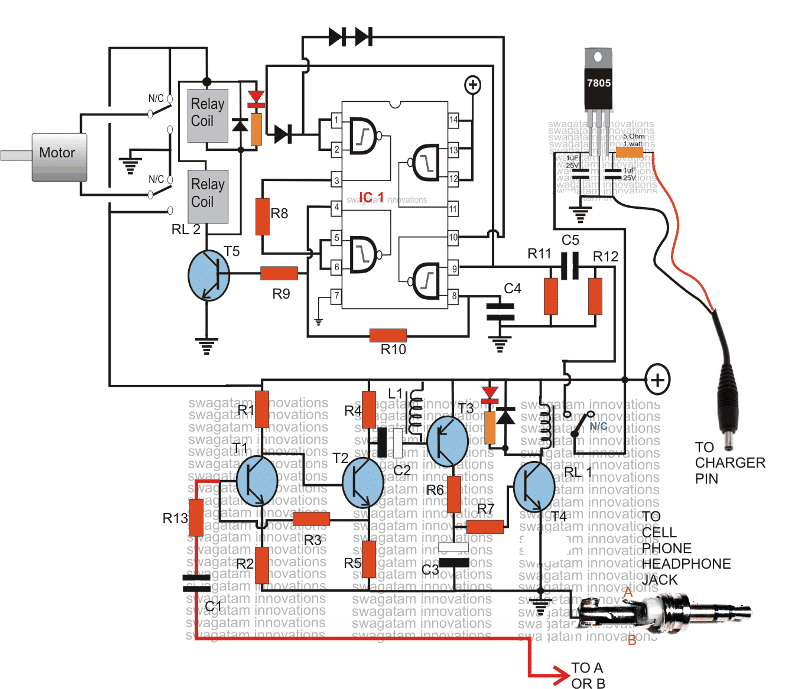In the following post I have explained a very simple circuit idea which can be used for controlling a motor's rotational direction i.e. for moving it either clockwise or anticlockwise through alternate miss calls from your cell phone.
The Circuit Concept
I have already discussed a novel cell phone controlled remote switch circuit where the unit can be used for switching an electrical gadget through the users cell phone. The user just has to call the remote system which responds to the blank calls and generates the required alternate switching of the connected gadget.
The same circuit has been used here also, the output is appropriately modified such that now the unit becomes suitable for toggling the rotation of a DC motor.
The circuit shown below can be used for controlling a motor rotational direction, let's try to understand it's functioning details:
The lower section of the diagram consisting of T1, T2, T3 and T4 along with the associated components forms a simple high gain audio amplifier circuit.
This circuit is used for amplifying the ringtone generated by the attached modem cell phone unit.
How it Works
The modem cell phone handset is an ordinary NOKIA 1280 cell phone which is permanently integrated with this circuit.
The above modem cell phone uses a prepaid SIM card and thus it becomes a self contained receiver module.
When this modem cell phone is called by the owner's cell phone, its ringtone activates and gets amplified by the above explained tone amplifier stage.
The amplified signal becomes powerful enough to triggers the relay RL1.
This relay holds or remains activated as long as the call stays connected, and breaks when the call is disconnected.
RL1's N/O contact is supplied with a 12v trigger to the adjoining stage which is a FLIP/FLOP stage, made by using four NAND gates from the IC 4093.
With every alternate missed calls from the owner's cell phone, the modem cell phone signals the tone amplifier, which activates RL1, and RL1 in turn flips or flops the IC1 circuit.
The output of the flip flop is connected with a relay driver circuit which is attached with two relays RL2 in parallel. You may use a single DPDT relay also for better convenience.
The contacts of the relays are configured in such a manner that flipping them produces opposite movements for the motor that's integrated to them.
The mains supply to the relay and the motor is taken from RL1, which means the motor flips with every subsequent "missed calls" and remains activated until the call stays connected, and then halts.
The circuit can be modified in many different ways as per the users specifications.
The modem cell phone should be appropriately assigned with a particular continuous ringtone while the default ringtone should be assigned to "empty", tis will make the unit immune to unknown numbers or wrong numbers, and the owner will be the sole controller of the attached circuit and the motors.

Parts List
All resistors are 1/4w 5% CFR unless otherwise stated.
- R1 = 22k
- R2 = 220 OHMS
- R3,R11,R12 = 100K
- R4,R6,R7,R9 = 4.7K
- R5 = 1K,
- R8 = 2.2M
- C1,C4,C5 = 0.22uF DISC TYPE
- C2,C3 = 100uF/25V
- T1,T2,T4,T5 = BC 547B
- T3 = BC557 B
- ALL DIODES = 1N4148
- IC1 = 4093
- RL1 = RELAY 12V/400 OHMS SPDT
- RL2 = Relay DPDT 12V/400 ohms
- L1 = small buzzer coil, small choke or similar.
- JACK = 3.5mm AUDIO JACK
- CELL PHONE MODEM = NOKIA 1280
Video clip showing the remote control operation of the circuit using a cellphone.
